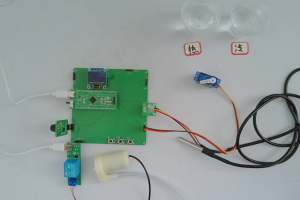设计说明书
总字数:28000+
针对当前淋浴系统普遍存在能效低、水温控制不精准、技术创新不足等问题,研发了一款智能淋浴控制系统。该系统创新性地将 STM32F103 微控制器作为核心控制单元,集成 DS18B20 水温传感器、人体热释电感应探头和舵机混水阀等模块,构建多传感器协同工作机制。
系统具备三大核心功能:首先,通过高精度水温传感器实时监测水温,并根据用户设定需求,运用 PID 算法精准控制舵机调节混水阀,实现水温的精确控制;其次,采用 LCD 显示屏实时显示当前水温,让用户直观掌握淋浴状态;最后,为保障用户安全,特别设计了过冷过热保护机制。用户可自由设定水温上下限,只有当水温处于安全区间内,系统才会启动出水功能,有效避免烫伤或着凉风险。
该系统通过智能化升级,不仅提升了淋浴体验的舒适度,更显著增强了使用安全性,为传统淋浴系统的技术革新提供了全新解决方案。
关键词:智能淋浴;单片机;舵机控温;PID算法;多传感器协作
In response to the common problems of current shower systems, such as low energy efficiency, inaccurate water temperature control, and lack of technological innovation, we have developed an intelligent shower control system. This system innovatively takes the STM32F103 microcontroller as the core control unit, integrates modules such as the DS18B20 water temperature sensor, pyroelectric infrared sensor for human body, and the servo mixer valve, and constructs a collaborative working mechanism of multiple sensors.
The system has three core functions: Firstly, through the high-precision water temperature sensor, it can monitor the water temperature in real time. According to the user’s set requirements, it uses the PID algorithm to precisely control the servo to adjust the mixer valve, achieving accurate control of the water temperature. Secondly, an LCD display screen is adopted to display the current water temperature in real time, allowing users to intuitively grasp the shower status. Finally, in order to ensure user safety, a cold and hot protection mechanism has been specially designed. Users can freely set the upper and lower limits of the water temperature. Only when the water temperature is within the safe range will the system start the water outlet function, effectively avoiding the risks of scalding or catching a cold.
Through intelligent upgrading, this system not only improves the comfort of the shower experience, but also significantly enhances the safety of use, providing a new solution for the technological innovation of traditional shower systems.
Key words:Smart Shower; Single-chip Microcomputer; Servo Temperature; PID Algorithm; Multi-sensor Collaboration
目 录
摘 要
ABSTRACT
第一章 绪 论
1.1 课题研究背景及意义
1.2 国内外研究现状
1.3 课题研究内容
第二章 控制系统总体方案设计
2.1总体方案设计
2.2 设计指标要求
2.3 元器件方案选型
2.4 舵机PWM调整角度
2.5 本章小结
第三章 系统硬件设计
3.2 STM32F103C8T6最小系统板设计
3.2 温度采集模块设计
3.3 OLED显示模块
3.4 舵机模块
3.5 人体热释电感应模块
3.5 外围模块电路设计
3.6 PCB设计
3.7 本章小结
第四章 系统软件设计
4.1 编程软件介绍
4.2 系统主流程设计
4.3 OLED显示子流程设计
4.4 独立按键子流程设计
4.5 温度检测模块子流程设计
4.6 舵机子流程设计
第五章 系统调试与成本分析
5.1 成本分析
5.2 软硬件调试
5.3系统调试方法及步骤
5.2系统调试过程
5.4 本章小结
第六章 总结与展望
6.1 全文总结
6.2 研究展望
致 谢
参考文献
附录A:硬件设计原理图
附录B:硬件设计PCB图
附录C:PCB硬件实物图
附录D:主要程序清单
购买后可查看具体内容!

